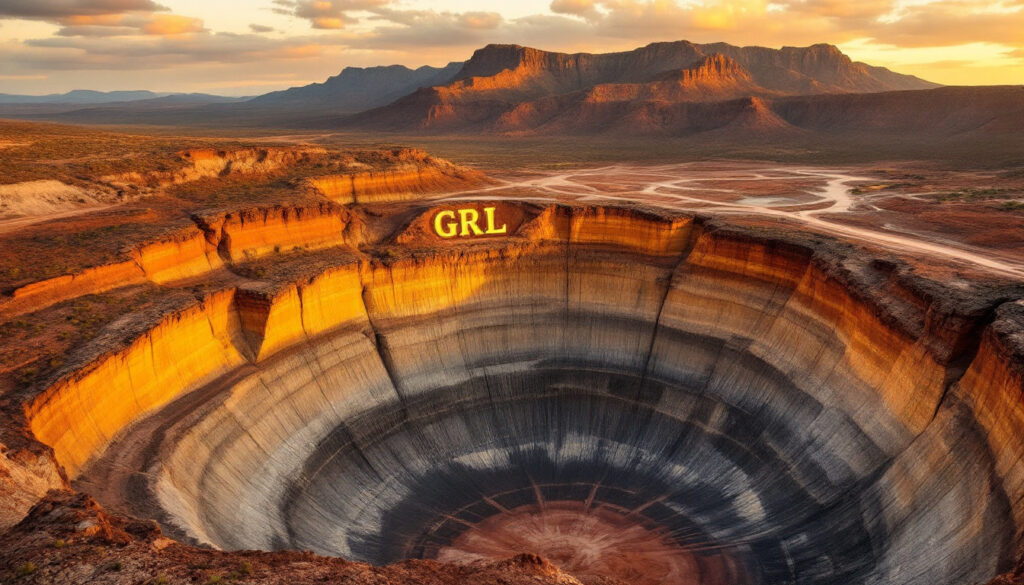Geophysical Breakthroughs Reveal Major Gold & Silver Extension Potential at Lewis Ponds
Godolphin Resources (ASX: GRL) has unveiled significant new exploration targets at its Lewis Ponds gold, silver and base metals project following breakthrough reprocessing of historical Induced Polarisation (IP) geophysical data. The results point to substantial potential for resource expansion beyond the current 398,000 oz gold and 15.9 Moz silver resource.
Major Geophysical Anomalies Extend Resource Potential by 2.15km
The reprocessed historical IP data has identified several large-scale chargeability anomalies that extend 1.6km south and 550m north of the existing mineral resource. These anomalies are particularly significant as the data shows a clear correlation between the IP chargeability signatures and the known gold and silver-rich sulphide mineralisation at the Lewis Ponds deposit.
"The results of the reprocessed data are spectacular," said Managing Director Jeneta Owens. "From the data, we can clearly see in the cross sections that the IP chargeability results are mapping gold and silver rich sulphide mineralisation that is well supported by the drilling already completed across the resource."
The key findings include:
- A 1.3km x 300m chargeability anomaly directly associated with the current mineral resource
- A 1.6km southern extension of this anomaly, divided into three target areas
- A 550m northern extension that remains largely untested
- Coincident geochemical anomalies in the southern zone that strengthen the exploration case
Untested Targets Show Early Signs of Mineralisation
What makes these findings particularly compelling is that limited historical drilling of these anomalies has already shown encouraging gold mineralisation, including:
- Southern Target Area 1: One historical hole intersected 20m @ 0.31g/t AuEq
- Southern Target Area 2: One historical hole returned 13m @ 1.46g/t AuEq
- Southern Target Area 3: One historical hole found 3m @ 0.83g/t AuEq
Despite these promising initial results, these large anomalies remain largely unexplored, presenting a significant opportunity for resource expansion.
Understanding Induced Polarisation: Why It Matters for Gold Exploration
Induced Polarisation (IP) is a geophysical technique that measures the chargeability of subsurface materials. It is particularly effective at detecting disseminated sulphide minerals such as pyrite, chalcopyrite, sphalerite, galena, and pyrrhotite, which often host or are associated with precious metals like gold and silver.
How IP Works in Mineral Exploration
IP surveys work by applying an electrical current into the ground and measuring how long electrical charges persist after the current is switched off. Sulphide minerals, which often host gold and silver, have the capacity to store electrical charge temporarily—a property known as chargeability. When these minerals are present, they produce a measurable delay in the decay of voltage after the applied current is cut off.
The strength of the chargeability response typically correlates with the concentration of sulphide minerals. At Lewis Ponds, the technique has proven highly effective as demonstrated by the clear correlation between high chargeability zones (4-8x background levels) and the known mineralisation.
Depth Limitations of Historical Data
An important consideration with the historical IP survey at Lewis Ponds is its depth limitation. The 1992-1993 survey could only penetrate to approximately 90m below surface. However, drilling has confirmed mineralisation continues to depths of more than 800m. This suggests the newly identified anomalies could represent significant mineralisation at depth as well as along strike.
This depth limitation creates an opportunity for modern geophysical techniques to identify deeper extensions of these anomalous zones, potentially revealing substantially more mineralisation than currently known.
Next Steps: Deeper IP Survey Planned to Define Drilling Targets
Godolphin is now planning a modern pole-dipole IP survey that will penetrate 300-400m below surface, significantly deeper than the historical survey's 90m limit. This will help refine drilling targets and potentially expand the resource envelope considerably.
"Plans are now underway for an expanded IP survey over the southern zone, using modern technology that can explore to greater depths," said Owens. "We look forward to providing further updates as the geophysical program progresses."
The new survey will utilise advanced electrode configurations and processing techniques that have been developed in the decades since the original survey. This modern approach is expected to provide clearer resolution of the chargeability anomalies and better define their extent at depth, which could significantly enhance the targeting of future drill programs.
Lewis Ponds: A Significant Gold-Silver Resource with Growth Potential
The current Lewis Ponds exploration by Godolphin Resources Ltd stands at 6.20 Mt at 2.0g/t gold, 80g/t silver, 2.7% zinc, 1.6% lead and 0.2% copper (JORC 2012 Inferred), containing 398,000 ounces of gold and 15.9 million ounces of silver. The deposit has historically been viewed primarily as a base metals project, but Godolphin's 2020 review revealed its significant precious metals potential.
The project sits within the prolific Lachlan Fold Belt, home to major mines including:
- Cadia-Ridgeway (Cu-Au)
- North Parkes (Cu-Au)
- Tomingley (Au)
- McPhillamys (Au)
Notably, previous geochemical work has identified similarities between Lewis Ponds and the nearby McPhillamys gold deposit, which hosts two million ounces of gold.
The deposit consists of stratabound, disseminated to massive sulphide lenses hosted in Silurian felsic to intermediate volcanic rocks. The mineralisation occurs within a locally highly structured zone within the western limb of a north-west plunging syncline, and has been defined as a steeply east dipping body with mineralisation occurring over a strike length of more than 2km.
Historical Context and Re-evaluation
The Lewis Ponds area has a mining history dating back to the 1850s, when it was already a small mining camp during the Ophir gold rush. Shallow underground mining took place at various zones including Spicer's, Lady Belmore, and Tom's Zone during the period 1887 to 1921.
While modern exploration by companies including Aquitaine, Amax, Shell, and Homestake focused primarily on base metals potential, a significant yet often overlooked fact is that much of Lewis Ponds' early development centred on the high grades of silver in its ores. It appears that silver was the major commodity mined at different points of the mine's history.
This historical focus on silver aligns with Godolphin's current emphasis on the precious metals component of the deposit, which has been highlighted through the company's re-evaluation of the project.
Why Investors Should Track Godolphin's Progress
Lewis Ponds represents a compelling investment proposition for several reasons:
- Substantial existing resource with 398,000 oz gold and 15.9 Moz silver
- Major expansion potential with 2.15km of untested or minimally tested IP anomalies
- Clear pathway to resource growth through planned deeper IP survey followed by targeted drilling
- Location in the prolific Lachlan Fold Belt near other major gold discoveries
- Gold and silver focus providing exposure to precious metals with base metals upside
Resource Extension Economics
The economics of resource extension at Lewis Ponds could be particularly favourable. The identification of IP anomalies that correlate strongly with known mineralisation provides a relatively low-cost way to target future drilling. Rather than conducting broad exploratory drilling across large areas, Godolphin can focus its efforts on the most promising zones identified by the geophysical surveys.
Timing and Market Conditions
With gold prices near all-time highs and silver showing strength, Godolphin's timing for advancing Lewis Ponds exploration by Godolphin Resources Ltd is opportune. The company has established a clear pathway to potentially expand its resource significantly, with relatively low-cost geophysical work leading to targeted, efficient drilling.
Comparison to Similar Projects
The Lewis Ponds project shows similarities to other successful developments in the region. The nearby McPhillamys gold deposit, with its two million ounce resource, provides a relevant comparison for the potential scale that Lewis Ponds might achieve with further exploration success.
For investors seeking exposure to gold and silver exploration in a tier-one jurisdiction, Godolphin's progress at Lewis Ponds merits close attention in the coming months.
Want to Explore Godolphin's Gold & Silver Potential?
Discover how Godolphin Resources is advancing its Lewis Ponds project with breakthrough geophysical results revealing major extension potential. With 398,000 ounces of gold and 15.9 million ounces of silver already defined, and 2.15km of untested anomalies, the resource growth opportunity is significant. To learn more about this exciting ASX investment opportunity in the prolific Lachlan Fold Belt, watch Godolphin's latest presentation video.




